Briefly: In our opinion, full (200% of the regular size of the position) speculative short positions in gold, silver and mining stocks are justified from the risk/reward perspective at the moment of publishing this alert.
The mining stocks showed strength recently, but it was not the case yesterday. Yesterday, silver took the lead, while gold and mining stocks took a breather. In fact, the white metal closed the day at a new monthly high. What can we infer from the above?
We can infer that the end of this rally is almost here or that we have just seen it. Silver tends to outperform right before the biggest slides, so it’s quite likely that we’ll see lower precious metals prices shortly.
Let’s take a closer look (chart courtesy of http://stockcharts.com).
Silver’s Outperformance
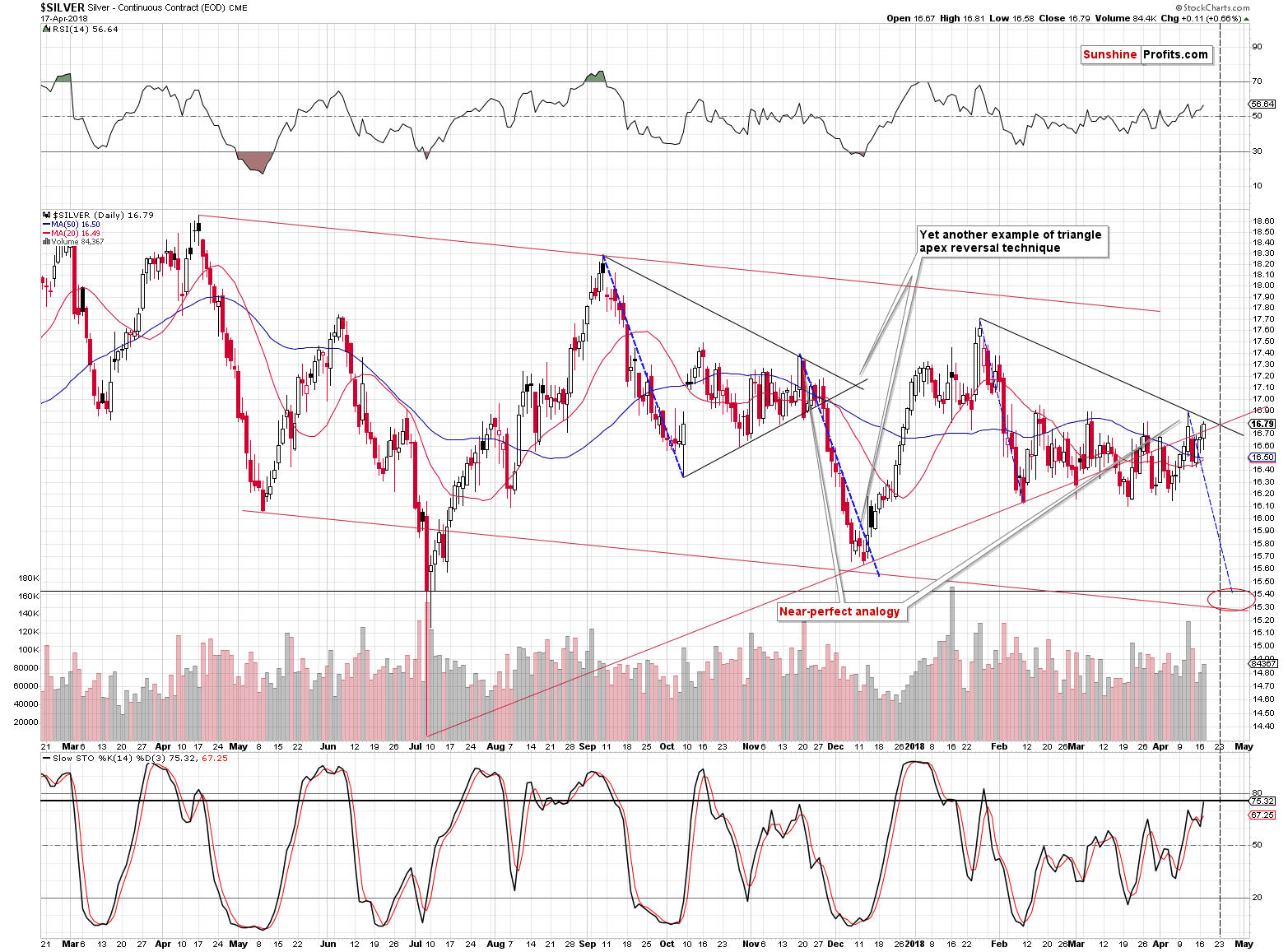
Silver moved only 11 cents higher, but it closed at a new monthly high and outperformed gold in a visible way. Together with the apex-based reversal in a week or so and the self-similar-based (blue dashed lines) bottom target in the final part of April, yesterday’s outperformance suggests a quick drop in the very near future.
It could also be the case that silver continues to move back and forth or even shows more strength for a couple of days and we’ll see a powerful slide then, but a decline before the end of the week seems more probable given the situation in the currency market.
Let’s keep in mind that based on silver’s oscillating characteristics, the next move in the white metal is likely to be very significant.
Lack of Action in Gold and Mining Stocks
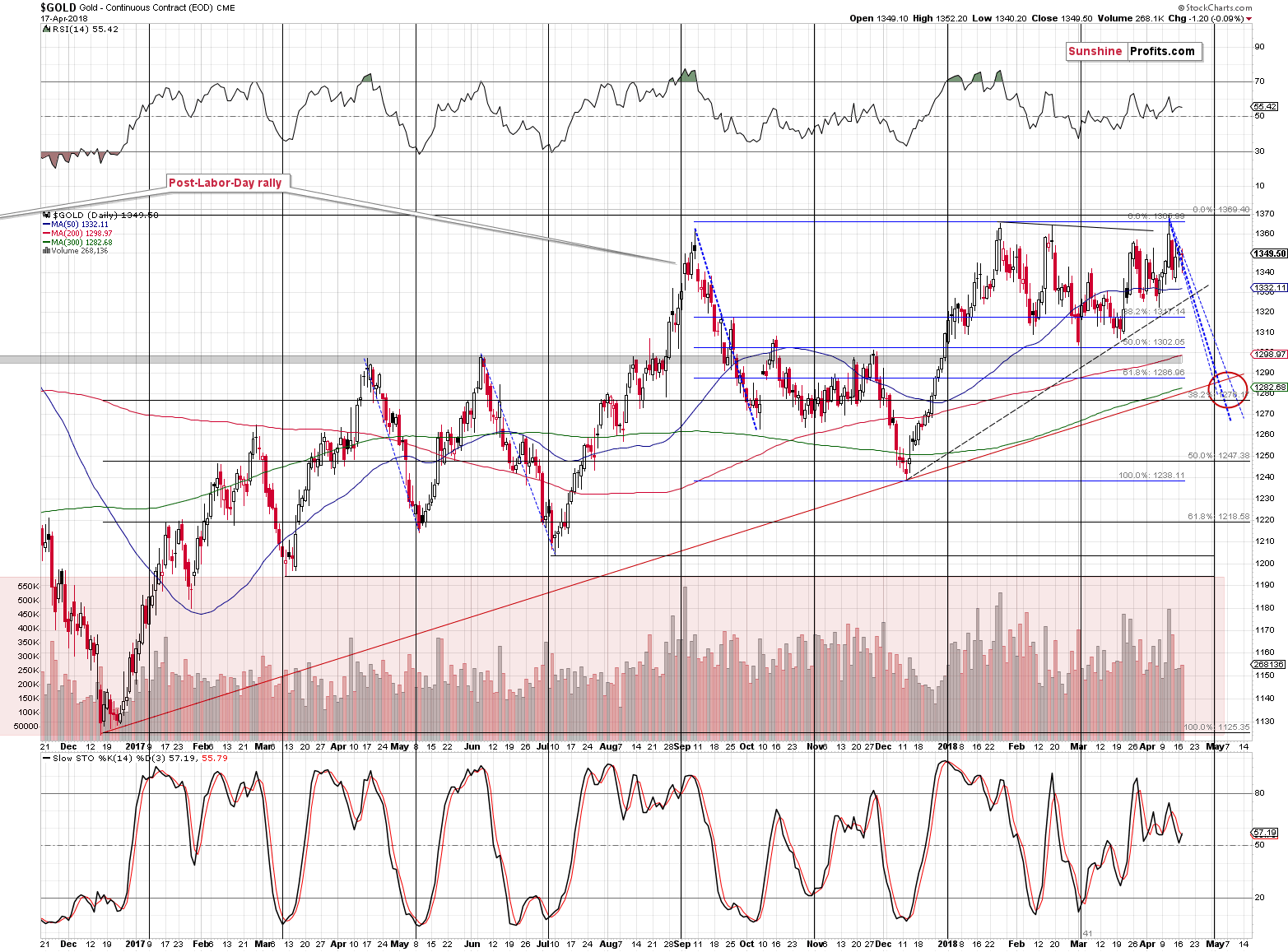
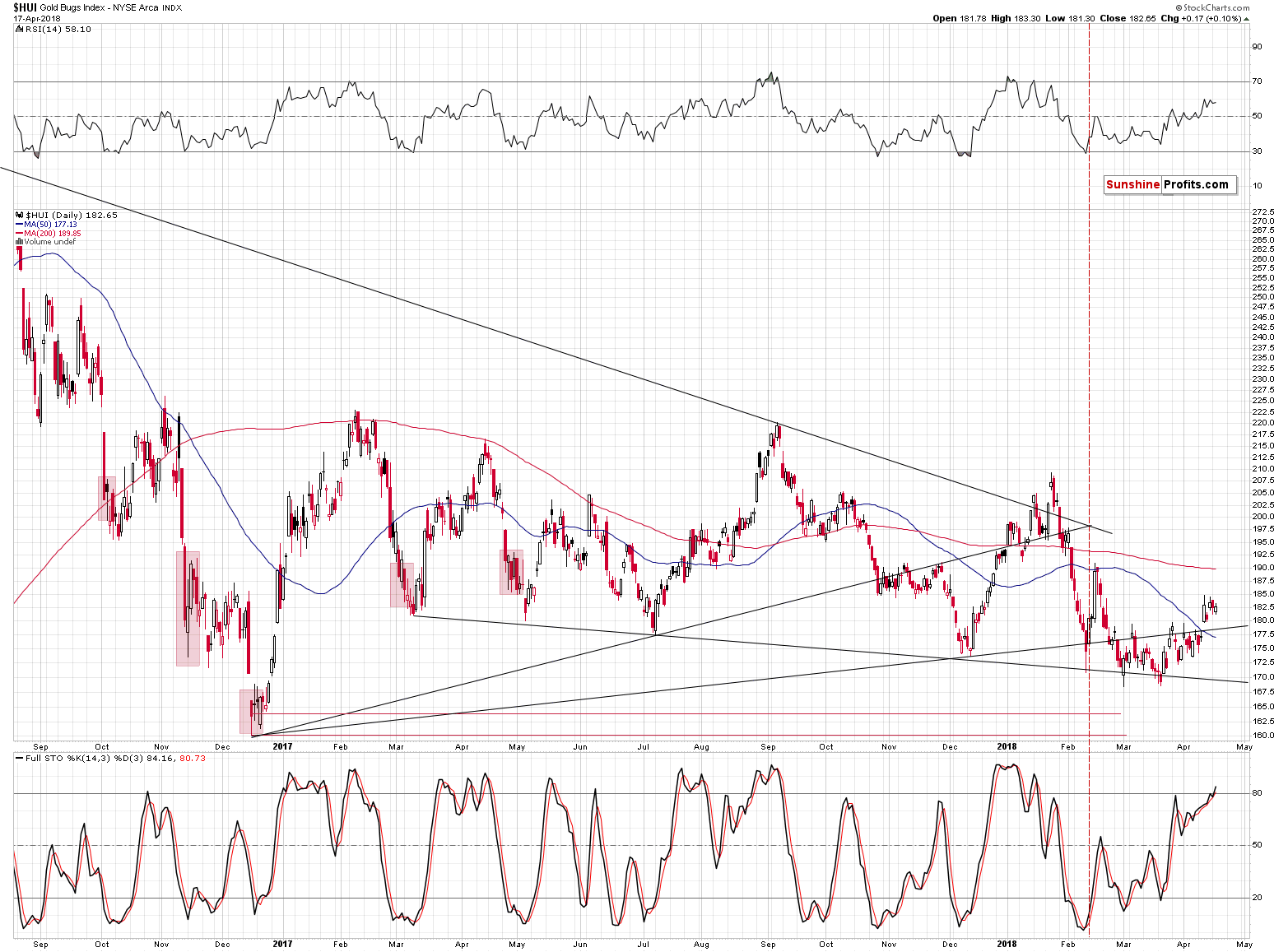
Gold stocks were up by 0.10% and gold was down by 0.09%. Some may say that it’s another case of gold miners’ outperformance, but in reality, the moves were too small to be considered meaningful. It’s much closer to the truth to say that both markets did nothing.
Gold’s lack of reaction didn’t invalidate anything. Gold’s decline is still in tune with the way gold used to decline in the past (blue dashed lines). Moreover, please note that in all 3 cases that these blue lines are based on, gold paused or corrected shortly after the initial post-top decline. The most recent very short-term move higher is therefore likely not a bullish sign, but a part of a declining pattern.
The situation in the forex market supports the above interpretation of the recent gold moves.
Forex: Reversal and Upcoming Breakdown
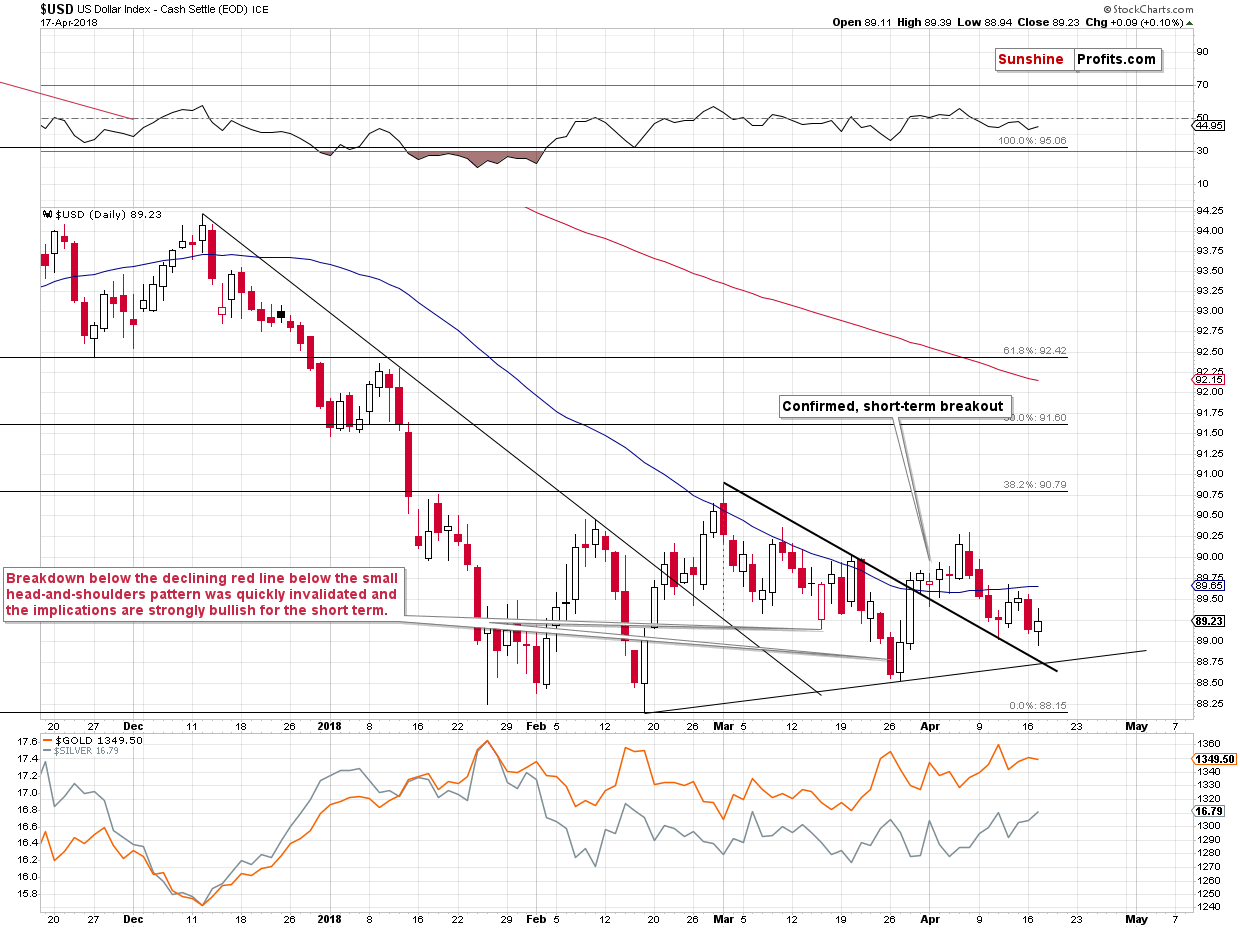
In yesterday’s alert, we wrote the following:
The USD Index moved lower, but not below the previously broken rising black support line, so technically nothing really changed. The thing that we would like to emphasize on the above chart is the short-term triangle and the proximity to its apex. The implication is that the USD Index is likely to reverse either today or tomorrow. The most recent short-term move was down, so the implications are bullish.
The USD Index indeed reversed yesterday, closing 0.10% higher after an intraday decline. This could have been the final reversal for this short-term decline or we can see the final one today.
This has profound implications for the following weeks and months.
Weeks, because a bigger rally in the USD Index is likely to translate into at least a visible decline in the EUR/USD.
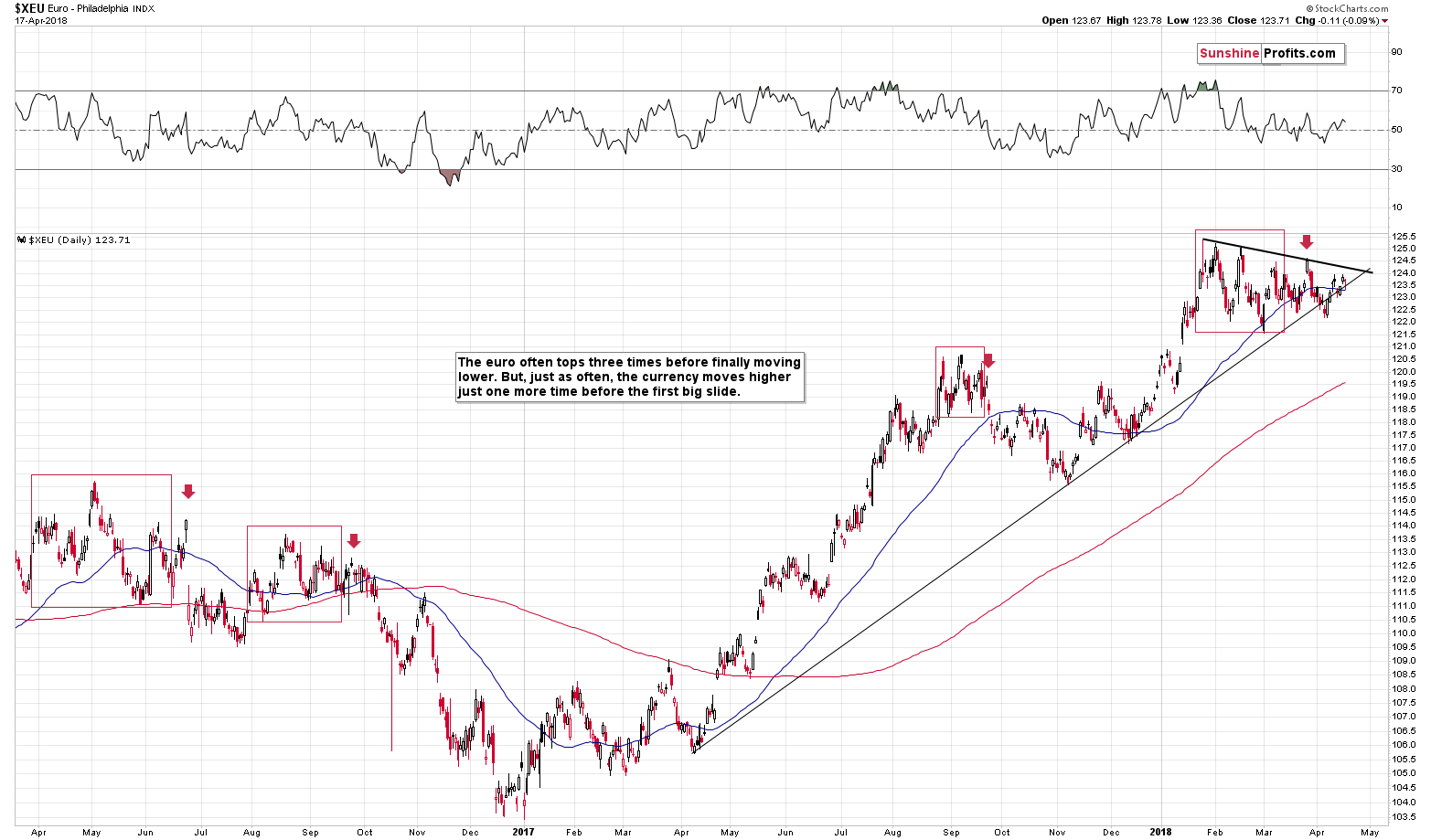
That’s important, because the euro is on the verge of a breakdown. Looking at the above chart alone it’s not clear if we’re going to see a breakout or breakdown, but keeping the USDX picture in mind, a breakdown is much more likely. A breakdown below the medium-term support line would be an important development, so the follow-up action would likely be significant. Especially that the euro has been consolidating for more than 2 months. The last time we saw something similar was between late August 2016 and early October 2016. The decline that followed was the biggest that we saw in recent history.
Before moving to the monthly implications of the USDX’s reversal, please note that the apex of the triangle in the euro is at the end of the month. That’s a perfect confirmation of the targets that we have for gold and silver based on the shapes of the previous declines, support lines, and gold’s cyclical turning point.
The above comments on the Euro Index remain up-to-date as well. The difference is that the EUR/USD is now lower and thus closer to the lower part of the triangle created by the medium-term rising support line. This makes the breakdown a bit more likely based on the above chart alone.
Since the breakdown was already likely based on the likely reversal in the USD, the above serves as a confirmation.
The implications for the precious metals market are bearish.
Before summarizing, we would like reply to one of the questions that we recently received – it seems that our reply might be useful to all subscribers.
Q&A – Interpreting our Analysis
Q: When you say this: In our opinion, full (200% of the regular size of the position) speculative short positions in gold, silver and mining stocks are justified from the risk/reward perspective at the moment of publishing this alert. Are you suggesting, Selling a Call? Around 130-128 Strike price? And in general how long are you suspecting to hold that position? While I love your alerts, I feel like I am left to read between your lines.
A: We’re trying to be as straightforward as possible, but there are several things that make this difficult:
- We can’t (legally) provide investment advice and investment advice is recommending a specific asset to a specific investor. Therefore, we can’t legally say what the preferred investment vehicle would be, or if it would be appropriate for the person asking this question. The more specific we get with a reply (for instance by telling one that they should use this specific strike price), the closer it gets to investment advice.
- Even if it was allowed, there would still be no universally best investment vehicle – some things are better for some people and some are better for others. In order to make this choice easier, we created a ranking with the popular ways to buy / trade gold, so that everyone can check what would suit them best. Long story short, when it comes to speculation, ETFs and ETNs seem to be the top choice for less advanced investors while futures and options seem more appropriate for those who have more trading experience.
- Investment and trading experience is only one factor that determines whether something should be used or not. There’s also the ability to take risk, the willingness to take risk, time that one can dedicate to the investments, liquidity preferences, maximum investment time horizon. Plus tax issues. Plus investor-specific unique considerations. Only after knowing and thoroughly discussing all this, would we be able to provide an investment recommendation for a given investor. Of course, it’s not possible to do it through a newsletter arrangement.
In other words, only an investment advisor could say if a given asset is appropriate for one’s portfolio in their specific situation. We know that there are services that (illegally) provide such details upon request without getting to know all the necessary details, but we care too much about you to provide you with a reply that’s quick and straightforward, but done without appropriate research and thus a low-quality one. Your finances and long-term success are more important to us than our analysis appearing straightforward at first sight. In other words, we want to provide you with the best service instead of only making it appear to be the best service.
So, what can we do through a newsletter arrangement? We can provide you with our opinions that will not be directed at a specific investor, but that will be our general point of view. Plus, we can provide you with as many general tools and rankings as possible so that it’s easy for you to get the answers you need.
In this case, the How to Buy ranking is likely useful, the ETF Ranking may be useful and the tools for options may be useful as well: Option Calculator, Pyramid Optimizer, and Position Size Calculator.
The Option Calculator makes quick what-if simulations (very useful when trying to determine an option’s price given a change in the price of the underlying asset like gold).
The Pyramid Optimizer helps to choose the optimal (maximizing the gain) strike price. The rule of thumb is usually between half or 1/3 of the way between the nearest strike price and the final strike price that you expect to be reached – for instance if the price is 99, you expect it to rally to 121 and the strike prices are 1 away from each other, then the optimal strike price would be 107, 108, 109, or 110. The more certain you are about the move, the closer to 110 would make sense. In general, it makes no sense to go with the strike price above half of the distance between the initial and final prices of a given move, as it increases the risk while decreasing the potential profits. The Pyramid Optimizer also checks if combining 2 or 3 sets of options makes sense (thus creating a pyramid).
The Position Size Calculator helps to choose the expiration date basing it on the probability of a given move taking place before the expiration and the profitability (using the Option Calculator might be helpful to determine the likely profitability). It’s usually a good idea to add at least a month to the predicted time target, just in case.
So, moving back to the question: are we suggesting selling a call? No. We are suggesting betting on lower prices of gold, silver, and mining stocks in general. Selling a call is indeed one of the possible ways to do so, but we can’t say if it’s the best way for your to proceed.
As far as holding the position is concerned, our best estimation at this time is that we’ll see a local bottom in about 2 weeks, or perhaps a bit sooner, so we would plan to hold this position at least until that time. It’s not clear if the rebound is going to be significant at this time, so we may choose to hold on to the short positions if we don’t get enough bullish confirmations (that’s why we are not changing the target prices below the summary).
Consequently, we would either sell a futures contract or buy a put option and if we were less experienced we would probably use an ETN to benefit from the declining prices. If we were to buy a put option on GLD, we’d go with the June 1, $125 options and we’d make sure that the position size was small as such short-term options are risky. Also, if you haven’t done so already, it might be a good idea to read our beginner’s guide, even if you’re not a beginner – it has an eye-opening simulation regarding position sizes.
We also received additional questions (i.a. about global gold & silver ETF holdings, silver/gold backwardation, option expiration dates, positive free cash flows in mining stocks and the moves in the latter in light of global uncertainty) and we’ll reply to them in the following alerts.
Summary
Summing up, the fact that gold didn’t manage to rally despite airstrikes in Syria and a visible decline in the USD Index and the fact that silver outperformed the yellow metal on an intraday basis yesterday, are both strong bearish signs. The recent strength in mining stocks was significant only if we consider the short-term price moves only – the bigger picture reveals that it’s nothing to call home about. Based on the triangle apex reversal patterns, it seems that the USD Index is about to reverse or that it has already reversed, which will likely have profound implications for the following weeks and months – i.a. through a declining euro. The outlook for the precious metals sector remains bearish.
As always, we will keep you – our subscribers – informed.
To summarize:
Trading capital (supplementary part of the portfolio; our opinion): Full short positions (200% of the full position) in gold, silver and mining stocks are justified from the risk/reward perspective with the following stop-loss orders and initial target price levels:
- Gold: initial target price: $1,218; stop-loss: $1,382; initial target price for the DGLD ETN: $53.98; stop-loss for the DGLD ETN $37.68
- Silver: initial target price: $14.63; stop-loss: $17.33; initial target price for the DSLV ETN: $33.88; stop-loss for the DSLV ETN $21.48
- Mining stocks (price levels for the GDX ETF): initial target price: $19.22; stop-loss: $23.54; initial target price for the DUST ETF: $39.88; stop-loss for the DUST ETF $21.46
In case one wants to bet on junior mining stocks' prices (we do not suggest doing so – we think senior mining stocks are more predictable in the case of short-term trades – if one wants to do it anyway, we provide the details), here are the stop-loss details and initial target prices:
- GDXJ ETF: initial target price: $27.82; stop-loss: $36.14
- JDST ETF: initial target price: $94.88 stop-loss: $41.86
Long-term capital (core part of the portfolio; our opinion): No positions (in other words: cash)
Insurance capital (core part of the portfolio; our opinion): Full position
Important Details for New Subscribers
Whether you already subscribed or not, we encourage you to find out how to make the most of our alerts and read our replies to the most common alert-and-gold-trading-related-questions.
Please note that the in the trading section we describe the situation for the day that the alert is posted. In other words, it we are writing about a speculative position, it means that it is up-to-date on the day it was posted. We are also featuring the initial target prices, so that you can decide whether keeping a position on a given day is something that is in tune with your approach (some moves are too small for medium-term traders and some might appear too big for day-traders).
Plus, you might want to read why our stop-loss orders are usually relatively far from the current price.
Please note that a full position doesn’t mean using all of the capital for a given trade. You will find details on our thoughts on gold portfolio structuring in the Key Insights section on our website.
As a reminder – “initial target price” means exactly that – an “initial” one, it’s not a price level at which we suggest closing positions. If this becomes the case (like it did in the previous trade) we will refer to these levels as levels of exit orders (exactly as we’ve done previously). Stop-loss levels, however, are naturally not “initial”, but something that, in our opinion, might be entered as an order.
Since it is impossible to synchronize target prices and stop-loss levels for all the ETFs and ETNs with the main markets that we provide these levels for (gold, silver and mining stocks – the GDX ETF), the stop-loss levels and target prices for other ETNs and ETF (among other: UGLD, DGLD, USLV, DSLV, NUGT, DUST, JNUG, JDST) are provided as supplementary, and not as “final”. This means that if a stop-loss or a target level is reached for any of the “additional instruments” (DGLD for instance), but not for the “main instrument” (gold in this case), we will view positions in both gold and DGLD as still open and the stop-loss for DGLD would have to be moved lower. On the other hand, if gold moves to a stop-loss level but DGLD doesn’t, then we will view both positions (in gold and DGLD) as closed. In other words, since it’s not possible to be 100% certain that each related instrument moves to a given level when the underlying instrument does, we can’t provide levels that would be binding. The levels that we do provide are our best estimate of the levels that will correspond to the levels in the underlying assets, but it will be the underlying assets that one will need to focus on regarding the signs pointing to closing a given position or keeping it open. We might adjust the levels in the “additional instruments” without adjusting the levels in the “main instruments”, which will simply mean that we have improved our estimation of these levels, not that we changed our outlook on the markets. We are already working on a tool that would update these levels on a daily basis for the most popular ETFs, ETNs and individual mining stocks.
Our preferred ways to invest in and to trade gold along with the reasoning can be found in the how to buy gold section. Additionally, our preferred ETFs and ETNs can be found in our Gold & Silver ETF Ranking.
As a reminder, Gold & Silver Trading Alerts are posted before or on each trading day (we usually post them before the opening bell, but we don't promise doing that each day). If there's anything urgent, we will send you an additional small alert before posting the main one.
=====
Hand-picked precious-metals-related links:
PRECIOUS-Gold loses its shine as dollar, stocks rise on risk appetite
=====
In other news:
U.S. Stock Futures Climb on Earnings, Geopolitics: Markets Wrap
Trump's CIA chief in secret meeting with North Korean leader: U.S. officials
IMF and World Bank Should Focus on 3 Transitions
Down $1 Trillion, World’s Worst Stocks Near Make-or-Break Level
Exclusive: OPEC's new price hawk Saudi Arabia seeks oil as high as $100 - sources
Kevin Warsh and Stan Druckenmiller Just Invested In a Cryptocurrency That's Designed to Be Boring
=====
Thank you.
Sincerely,
Przemyslaw Radomski, CFA
Founder, Editor-in-chief, Gold & Silver Fund Manager
Gold & Silver Trading Alerts
Forex Trading Alerts
Oil Investment Updates
Oil Trading Alerts



